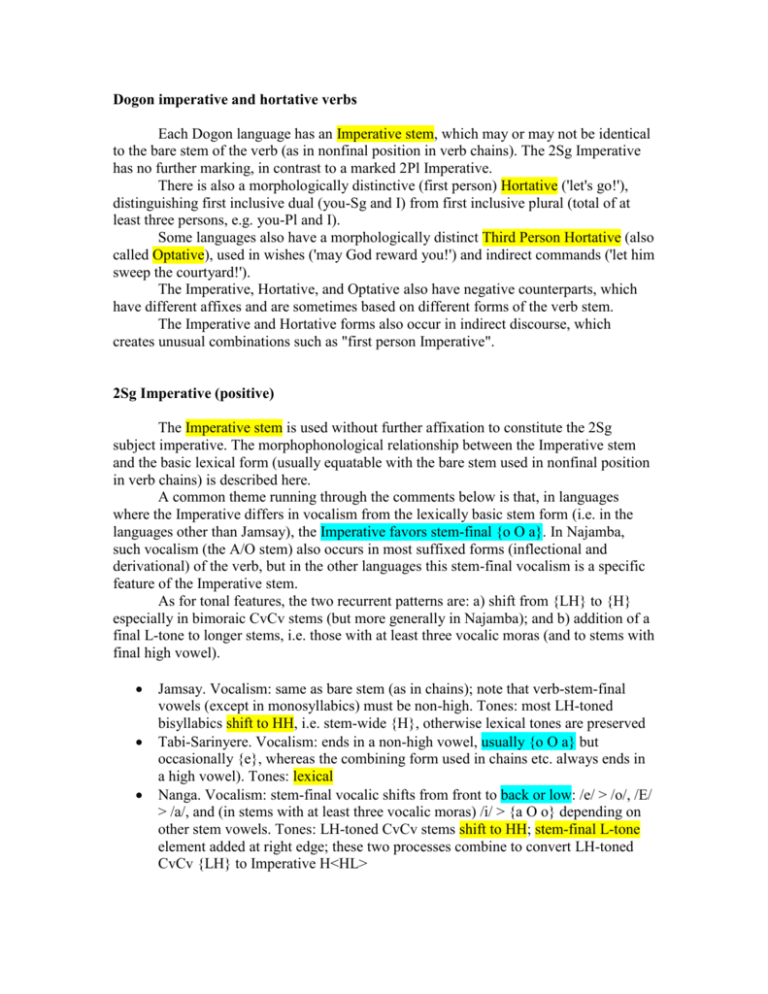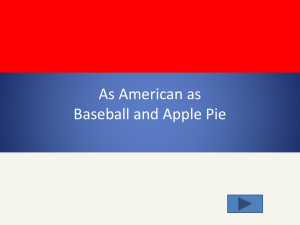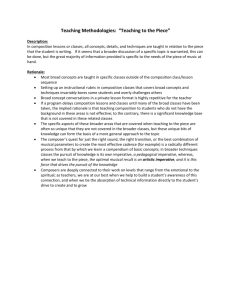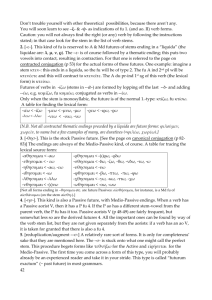Dogon imperative and hortative verbs
advertisement

Dogon imperative and hortative verbs
Each Dogon language has an Imperative stem, which may or may not be identical
to the bare stem of the verb (as in nonfinal position in verb chains). The 2Sg Imperative
has no further marking, in contrast to a marked 2Pl Imperative.
There is also a morphologically distinctive (first person) Hortative ('let's go!'),
distinguishing first inclusive dual (you-Sg and I) from first inclusive plural (total of at
least three persons, e.g. you-Pl and I).
Some languages also have a morphologically distinct Third Person Hortative (also
called Optative), used in wishes ('may God reward you!') and indirect commands ('let him
sweep the courtyard!').
The Imperative, Hortative, and Optative also have negative counterparts, which
have different affixes and are sometimes based on different forms of the verb stem.
The Imperative and Hortative forms also occur in indirect discourse, which
creates unusual combinations such as "first person Imperative".
2Sg Imperative (positive)
The Imperative stem is used without further affixation to constitute the 2Sg
subject imperative. The morphophonological relationship between the Imperative stem
and the basic lexical form (usually equatable with the bare stem used in nonfinal position
in verb chains) is described here.
A common theme running through the comments below is that, in languages
where the Imperative differs in vocalism from the lexically basic stem form (i.e. in the
languages other than Jamsay), the Imperative favors stem-final {o O a}. In Najamba,
such vocalism (the A/O stem) also occurs in most suffixed forms (inflectional and
derivational) of the verb, but in the other languages this stem-final vocalism is a specific
feature of the Imperative stem.
As for tonal features, the two recurrent patterns are: a) shift from {LH} to {H}
especially in bimoraic CvCv stems (but more generally in Najamba); and b) addition of a
final L-tone to longer stems, i.e. those with at least three vocalic moras (and to stems with
final high vowel).
Jamsay. Vocalism: same as bare stem (as in chains); note that verb-stem-final
vowels (except in monosyllabics) must be non-high. Tones: most LH-toned
bisyllabics shift to HH, i.e. stem-wide {H}, otherwise lexical tones are preserved
Tabi-Sarinyere. Vocalism: ends in a non-high vowel, usually {o O a} but
occasionally {e}, whereas the combining form used in chains etc. always ends in
a high vowel). Tones: lexical
Nanga. Vocalism: stem-final vocalic shifts from front to back or low: /e/ > /o/, /E/
> /a/, and (in stems with at least three vocalic moras) /i/ > {a O o} depending on
other stem vowels. Tones: LH-toned CvCv stems shift to HH; stem-final L-tone
element added at right edge; these two processes combine to convert LH-toned
CvCv {LH} to Imperative H<HL>
Beni. Vocalism: stem-final vocalic shifts from front to back or low: /E/ > /a/, /i/ to
{a o} depending on other stem vowels. Tones: LH-toned CvCv bisyllabics ending
in non-high vowel shift to HH (actual surface tones); longer stems, and CvCv
bisyllabics ending in a high-vowel, add a stem-final L-tone element.
Najamba. Vocalism: identical to the A/O stem (which is also used before many
derivational and inflectional suffixes); the A/O stem has an overlaid stem-wide {e
o} [+ATR] melody ({e o} rather than #{E O}), and has stem-final /a/ or /o/
depending on the stem's underlying lexical ATR harmonic class. Tones: shifted to
{H} (i.e., all high) for all syllabic/moraic types.
2Pl Imperative (positive)
The 2Pl Imperative consists of the Imperative stem (see just above) plus the
special suffix given below for each language. For comparison, the usual 2Pl pronominalsubject suffix, as it occurs in indicative inflected verbs, is shown in the right-hand
column.
language
2PlImprt suffix
a)
Tabi-Sarinyere [none]
b)
Jamsay
Nanga
Beni
Najamba
-y (L)
-ndi (L)
-n -ni (L)
-m (L)
added to...
2PlS suffix elsewhere
Imperative stem
Imperative stem
Imperative stem
Imperative stem
-be
-w
-w
-oo/-OO
In Tabi-Sarinyere, there is no suffixal 2Pl Imperative. However, at clause-level,
the usual 2Pl subject pronominal /a/, which is positioned at or near the clause onset,
Negative Imperative (Prohibitive)
The Negative Imperative, also called Prohibitive, is morphologically distinct from
the (positive) Imperatives. There is a suffix (in some cases, arguably a clitic) for
NegImprtSg. The plural counterpart adds an additional suffix or enclitic.
language
2SgNegImprt
2PlNegImprt
a)
Jamsay
-y (H)
[2SgNegImprt] lay (<HL>)
b)
Nanga
Beni
Najamba
a.
b.
-ra -nda (H) -ndaa (<LH>) [2SgNegImprt]-ndi (HL)
-rE (H)
-rE-n (<HL>) -rE-ni (HL)
-la (L)
-nOO (<HL>)
-la-m (L)
-nO-m (<HL>)
Tabi-Sarinyere
a.
b.
-le/-lE -re/-rE (H)
-ku (H)
The stem to which the Negative Imperative suffix is added is characterized as
follows (the two Najamba suffixes are added to very different stems):
Jamsay. Vocalism: lexical (= bare stem). Tones: dropped to {L}
Tabi-Sarinyere. a) before -le (and variants), vocalism is that of the usual
combining form (requiring final high vowel); tones lexical except {LH}
simplifies to {L} before the H-toned suffix. b) before -ku, vocalism is again that
of the combining form; all tones dropped to {L} before the suffix. As with
positive Imperatives, 2Pl subject is indicated by a clause-initial subject
pronominal rather than in the verb itself.
Nanga. Vocalism: bisyllabic CvCv- shifts final vowel to /i/, otherwise lexical.
Tones: lexical.
Beni. Vocalism and tones: lexical.
Najamba. a) before -la, vocalism is that of the A/O stem ([+ATR] harmonic
overlay, stem-final /a/ or /o/); tone contour involves a partial {...HL} overlay
realized on the noninitial syllables of many stems (but vacuous with
monosyllabics and LH-toned short-voweled bisyllabics); b) before -nOO,
vocalism is that of the E-stem as in the unsuffixed Perfective, ending in /e/ or /E/;
tone contour is {L} (=all low).
linear position of pronominal object in imperatives (Tabi-Sarinyere)
Direct objects normally have the same linear position and (if applicable)
Accusative case-marking in imperative clauses as in other main clauses.
In Tabi-Sarinyere, however, a pronominal direct object (for 1st/2nd as well as 3rd
person categories) often (though not always) follows the verb in singular-subject
imperative clauses (1.a), whereas in other clause types the object must precede the verb
(1.b). Object postposing is not possible in 2Pl subject imperatives (1.c).
(1)
a.
shake-Imprt 1SgO
'Shake-2Sg me!'
b.
2SgS 1SgO shake-Perf
'You-Sg shook me.'
c.
2PlS 1SgO shake-Imprt
'Shake-2Pl me!'
It is difficult to interpret this object-postposing in (1.a). One is tempted to say that
it is a device to avoid clause-initial position, and this would help understand the
difference between (1.a) and (1.c) in particular. However, if we replace the clause-initial
2Sg subject morpheme in (1.b) with a 3Sg subject morpheme, which follows the verb, we
see that pronominal objects can occur clause-initially: [1SgO shake-Perf 3SgS] 'he/she
shook me'.
Comparison of (1.a) with the Spanish type sacude-me! 'shake me!' is suggestive.
In addition, there are numerous languages where the second person subject of imperatives
appears to be structurally absent, allowing a direct object to acquire subject-like casemarking (as in some Uto-Aztecan languages) and/or linear position.
Hortative (first person)
The Hortative (positive) used with first person inclusive subject ('let's go!') always
has a nonzero suffix (arguably a clitic). Two such forms occur: a specifically 1InclDu
(first inclusive dual = 'you-Sg and I') form, and a more common 1InclPl form used when
the number of individuals totals three or more ('you-Pl and I' or 'you-Sg he/she and I').
language
1InclDuHort
1InclPlHort
a)
Jamsay
Nanga
Beni
-m (H)
-ma (L)
-m (H)
-mayⁿ (<HL>)
-mayⁿ (L)
-mayⁿ (<HL>)
b)
Najamba
-y (H)
-y (L)
c)
Tabi-Sarinyere
monosyllabic:
other:
-yⁿe/-yⁿE (H)
-e/-E (H) replacing stem-final vowel
The markedness relationship between 1InclDu and 1InclPl varies from language
to language. The 1InclPlHort is marked in Jamsay (i.e. the "dual" form is used, under
some conditions, for three or more individuals). In Tabi-Sarinyere, there is no number
distinction, and 1Pl subject is expressed in the usual way by means of a clause-initial
subject pronoun.
The stem to which the Hortative (positive) suffix is added is as follows:
Jamsay. Vocalism: = bare stem. Tones: dropped to stem-wide {L}
Nanga. Vocalism: final /i/ > {o O a E e} copied from earlier stem vowel. Tones:
lexical ({H} and {LH} remain distinct)
Beni. Vocalism: lexical. Tones: dropped to {L}.
Najamba. Vocalism: A/O stem (i.e. [+ATR] harmonic melody, stem-final /a/ or
/o/). Tones: {L} before 1InclDuHort -y (H) resulting in word-level L...<LH>
pattern; {LH} before 1InclPlHort -y (L) resulting in word-level L...<HL>.
Tabi-Sarinyere. Vocalism: combining form (but in non-monosyllabics this is
obscured by the contraction of the stem-final and suffixal vowels). Tones: lexical.
Hortative Negative
This form ('let's not go!') is based morphologically on the (unmarked, i.e.
elsewhere 2Sg subject) Negative Imperative form, to which is added a Hortative Negative
suffix or enclitic. In Najamba, the two different Negative Imperative forms each have a
corresponding negative (details about the respective stem vocalisms and tone contours
are not repeated here).
language
1InclDuHortNeg
1InclPlHortNeg
a)
Jamsay
Nanga
Beni
[NegImprt] la-m (H)
[NegImprt]-ma (H)
[verb]-rE-m (<LH>)
[NegImprt] la-may ⁿ (H<HL>)
[NegImprt]-may ⁿ (L)
[verb]-rE-may ⁿ (L<HL>)
b)
Najamba
a.
b.
[NegImprt]-la-y (<LH>)
[NegImprt]-la-y (<HL>)
[NegImprt]-nOO-y (<HL>)
c)
Tabi-Sarinyere
a.
(NegImprt verb plus 1Pl clause-initial subject pronominal)
b.
(Imperfective Negative -na/-rⁿa (H) may also be used)
paired-hortative compounds (Tabi-Sarinyere)
An interesting twist on Hortatives is that, in Tabi-Sarinyere, two hortative forms
from different verbs may be juxtaposed to create an unusual compound verbal noun
denoting back-and-forth actions. This hortative compound can be followed by the 'do'
verb to constitute a predicate. Example: [[go.in-Hort] [go.out-Hort] do] = 'keep going in
and coming out'. In some examples, like this one, the two verbs denote (semantically)
reverse actions, leaving the agent in the same position as before, but there are also
examples like [[fly-Hort] [land-Hort] do] = 'keep flying (short distances) and landing',
where the motion episodes cumulate rather than reversing each other.
Third Person Hortative (= Optative).
Some but not all of the languages have a distinct verb form for Third Person
Hortative (or Optative), as in 'may God protect you!' (wish) and 'let him sweep the
courtyard!' (indirect command). The forms are these:
language
a)
Jamsay
Tabi-Sarinyere
3SgHort
3PlHort
[none]
[none]
b)
Nanga
Beni
Najamba
-y (or final vowel > /i/)
-y (tone variable)
-y-bO (...H)
-na (H)
-woo (H)
The stem to which the Third Person Hortative endings are added is as follows:
Nanga: Vocalism: a final non-high vowel (except final /e/ in trimoraic or longer
stems) is raised to /i/. Tones: final L-tone added at end of stems that have at least
three vocalic moras, resulting in final <HL> tone except that lexical HHH > HHL.
Beni: Vocalism: lexical. Tones: monosyllabics (Cv), which in many other
contexts have uniform H-tone, divide lexically into one set with L and another
with H tone before -y (H-toned); longer stems ending in a non-high vowel,
including the suffix, appear as HH or HHL depending on mora count from lexical
{H}, and L<LH> or LHL depending on mora count from lexical {LH}; longer
stems ending in a high vowel have bisyllabic HL (from {H} or {LH}) and
trisyllabic HHL from {H} or LHL from {LH}.
Najamba. Vocalism: A/O stem. Tones: lexical.
Third Person Hortative (= Optative) Negative
For Najamba, the Third Person Hortative Negative is constructed by adding the
(positive) Third Person Hortative suffixes, Sg -na (H) and Pl -woo (H), to the Imperative
Negative form ending in -nOO (<HL>).
Nanga: no data.
Beni: 3Sg Hortative Negative -rE-y (H), i.e. Hortative -y following Imperative
Negative form; 3Pl Hortative Negative -rE-y-bO (HH).
Imperative and Hortative in indirect discourse
Imperative and/or Hortative verb forms may be used in indirect discourse, i.e.
quoting commands and exhortations uttered by another speaker. Since the deictic
structure of the quoted and current speech events are typically different, the addressee of
the original command or exhortation (i.e. the second person or first person inclusive
subject of the verb) may now be in any pronominal person. For example, we might get
first person subject in [1Sg come-Imprt], for which the most idiomatic free translation is
'shall I come?' or 'Did you say to come?', but which functions to query or clarify a
command from the addressee or some other person. The "subject" (here 1Sg) is really a
quoted vocative. That is, the original utterance was "(hey) you! Come!" and a fairly
literal translation of the quoted form is "(hey) me? Come?". (In some languages, the
Hortative is apparently preferred to the Imperative in such quoted commands.)
For languages like Jamsay that lack a Third Person Hortative form, an indirect
Imperative or (regular) Hortative is additionally used in wishes ('may God ...!') and the
like.
Details for the various languages are given below. Additional detail will be added
as analysis of textual corpora progresses.
Jamsay: since there is no morphologically distinct Third Person Hortative, the
form used in e.g. 'may God protect you!' (wish) and 'let him sweep the courtyard!'
indirect command) is identical to the 2Sg subject Imperative, which in this
function is invariant. This is also used with first person subject, quoting (or
seeking to confirm) another speaker's imperative directed at the current speaker
('Shall I hit my dog?' in the context of clarifying what the addressee wants the
speaker to do). The only explicit indication that the clause is not a standard
second-person imperative is that the subject is expressed, either by a NP or by an
independent first or third person pronoun. The "subject" NP/pronoun is best taken
as a reported vocative, and it cannot serve as antecedent for a reflexive within the
clause.
Tabi-Sarinyere: first and third person pronouns, and NPs, may occur as "subjects"
of quoted imperatives
Nanga: the Third Person Hortative is attested, followed by the polar (yes/no)
interrogative particle, in queries of speaker-directed commands. For example,
'shall I bring a mango?' in the pragmatic context described above is attested in the
form 'mango bring-Hort yes/no?'.
Beni: the Third Person Hortative is used in queries of speaker-direct commands,
as in Nanga.
Najamba: the Imperative form is attested in quoted commands with first person
"subject", as in 'Shall I bring a mango?'.
Imperatives and horatives in greetings
Some Dogon greetings that are keyed to particular times of day include
morphologically imperative or hortative verb forms, but with retrospective rather than
prospective temporal reference. For example, the 'good morning!' greeting is literally
"spend the night!", where one might have expected a polar interrogative in perfective
form ("Did you spend the night well?").







